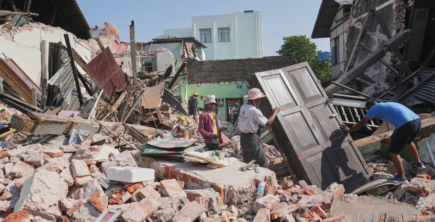
Healthy Individuals & Communities

People carry their belongings as they leave their homes, damaged by Friday's earthquake in Naypyitaw, Myanmar. (AP Photo)
As of this writing, the death toll in Myanmar’s devastating earthquake has passed 2,700, with hopes of finding more survivors beginning to fade. Myanmar already faced a humanitarian crisis due to its civil war, which has displaced more than three million people; now hunger and disease outbreaks are projected to get worse. At this stage, the full scale of the disaster remains unclear, since access has been slow to remote areas where communications are down. One thing is certain: Myanmar needs help now.
Here are six organizations currently working to provide immediate and/or long-term emergency assistance to those affected by this crisis:
Direct Relief is mobilizing emergency response efforts in coordination with the ASEAN Coordinating Center for Humanitarian Assistance on Disaster Management, or AHA Center. The response is being guided by a standing collaboration agreement between Direct Relief and the AHA Center, established to strengthen and support regional disaster response across Southeast Asia. This established connection with the AHA Center enables rapid, coordinated response and effective communication in support of ASEAN member states. Direct Relief is also in contact with local partner organizations and healthcare providers to determine the immediate medical needs.
IRC partners have started distributing essential support to the earthquake-hit communities, including water, hygiene kits, and critical medical assistance. The mobile medical health team is en route to Mandalay, near the epicenter of the earthquake, with essential medicines to provide life-saving aid.
The IRC began working in Myanmar in 2008 following an emergency response to a devasting cyclone that year. They have since expanded their activities, and Myanmar is currently ranked third on the IRC’s Emergency Watchlist due to the worsening humanitarian crisis in the country.
CARE is working on the predicted urgent needs for health and medical services, food and nutrition, shelter, clean water and more through their Myanmar Crisis Fund. CARE’s response prioritizes women and girls, the elderly, families with young children, and those unable to access other emergency services.
“All CARE staff in Myanmar are safe, but the earthquake has caused damage in Mandalay and nearby areas,” said Arif Noor, CARE Myanmar Country Director. “This powerful quake struck a country already in crisis, with 19.9 million people in need of humanitarian assistance. The response remains significantly underfunded, and this disaster has only worsened an already fragile situation. CARE and our partners are urgently assessing the damage and preparing to support affected communities.”
Doctors Without Borders medical humanitarian staff in Myanmar and neighboring countries have the capacity to respond at scale to the needs of affected communities as soon as authorities facilitate swift and unhindered access for teams to do assessments and provide medical care. Teams are ready to intervene and emergency response planning is underway. Their priority at the moment is to deploy assessment teams, and ideally an emergency trauma care team.
Doctors Without Borders has been working in Myanmar since 1992, with a focus on providing HIV and tuberculosis care, emergency responses to national disasters and conflict, as well as support to the persecuted Rohingya people in Rakhine state.
World Central Kitchen’s Relief Team is en route to Southeast Asia. They are working with local restaurants and members of the community in both Myanmar and Thailand to establish connections and access the most impacted areas.
Mercy Corps is preparing to scale-up its existing programs to meet urgent needs following the earthquake. Mercy Corps is supporting its partners to assess the situation and identify rapid and suitable response work in coordination with local actors. Mercy Corps expects that immediate needs will be shelter, food, water, and cash assistance to meet their basic needs and rebuild for the future.
Mercy Corps has been working in Myanmar since 2008 and has reached over 600,000 people since 2022 with economic opportunities, and green agricultural growth in the face of worsening climate change, and community resilience.
Donations after a crisis can be a lifeline, but there’s an opportunity for them to be much more. Read our guide to effective grantmaking after a natural disaster or other crisis.

Healthy Individuals & Communities

Our Community

Philanthropy

Read the stories and hear the voices of social change leaders fighting for justice.